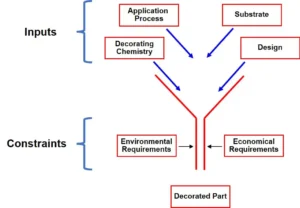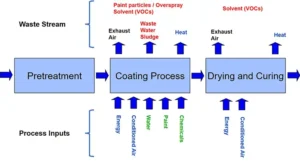What is Next in Plastic Decorating?
By Paul Uglum, Uglum Consulting, LLC
In looking at advances in plastic decorating, it is important to understand what is driving change and which new technologies are emerging. It also is useful to understand which problems they solve or advantages they bring to either the manufacturer or the eventual user. What needs do these new materials or processes meet? Understanding the strengths and weaknesses of both the current and the new decorating technologies allow the best choice for each application.
Plastic decoration serves many purposes and often multiple purposes simultaneously. Decoration increases value by improving aesthetics and desirability, conveying information, improving durability in the application and providing additional functional features such as haptics.

All successful plastic decoration is the result of a combination of the materials used, the process technology, the part design and the eventual application in the field. Although the techniques often are categorized by the application technology, all of the factors are important and innovation can come from any one of the inputs. The best innovations often are improvements in existing technologies or innovations first introduced into one market and then improved and adopted by others. It is important to consider what constitutes plastic decoration and the technologies used to accomplish it, and then to look carefully at advances in the field that may provide opportunities. An existing technology that works well is better than a new one that is not quite ready and leads to unexpected consequences.
Plastic decoration consists of a large family of unrelated technologies used in a wide variety of industries. A recent article 1 listed the largest 100 plastics molders by sales volume. In looking at the secondary operations they offered, three-quarters had plastic decoration and/or painting capability in-house. When this is combined with the many other plastic manufacturing technologies and a wide variety of applications, size and range of plastic decorating technologies is enormous. The many variations (techniques and materials) make plastic decoration a difficult field to fully characterize or study. In addition to the many technologies, the performance requirements of the various end markets served vary significantly from one use to many decades in harsh environments. One size does not fit all applications.
Coatings
Coating processes remain the most common and important industrial decorating processing technology. Coatings either can be used by themselves to add value or in combination with other decorating techniques. Is a coating a decoration? It can be argued either way, but what cannot be argued is the importance of the value coatings bring to the plastic decoration process. Coatings serve many purposes including protecting parts produced with other decorating technologies and improving adhesion to difficult substrates. They also serve as a carrier for value-added properties with functional as well as decorative outcomes.
Despite the significant disadvantage of poor material transfer efficiency, and simultaneous production of waste through volatile organic compounds (VOCs), and overspray, atomization is still the dominant method for industrial-scale coating when visual attractiveness or performance are required. Spray coating enables uniform coating with intricate parts of complex shapes. If a wide range of colors or coating technologies are used there is practically no alternative.

A coating is a semi-finished product that is transformed into a continuous smooth film. This usually is accomplished with atomization which produces droplets that are conveyed (accelerated to the part) in order to provide the necessary free surface energy. Atomization can be achieved with conventual spray guns (air pressure), airless guns (hydraulically), ultrasonic and bell (centrifugal force). Each method has advantages and limits, and the choice should be based upon the specific application and materials.
Many techniques exist for applying coatings – the best choice is the one that meets the intended outcome and production requirements, such as part geometry and application. A quick look shows that there are many other options for applying a coating to a substrate. Each has its advantages and ideal market. Beyond spray coating, coatings can be applied by brush coating, roller, blade, spin, flow and dip coating. Again, the choice of the best for the application is based on the application, part design, volume of parts to be coated and the production volume. Thin coatings also can be applied using in vacuum systems using chemical vapor deposition and sputtering.
A recent RADTECH International web-based discussion of the paint shop of the future – although focused on vehicle exteriors – demonstrates the issues and opportunities which are much the same for all coating and decorating technologies. The identified improvement opportunities are reducing energy utilization and waste. Transfer efferences – the amount of coating that actually goes on the part – are as low as 55% and a large amount or consumed energy is used in conditioning the makeup air and curing the coating. When decorating small parts or short runs, the transfer efficiencies and energy consumption can be even worse.
The primary barriers to changing to a new technology come from the very harsh end-use environment (durability requirements) and the high cost of any field related issues. As a result, the automotive industry is very risk adverse, and more willing to change processes than established materials.
The fundamental problems to solve are energy consumption, transfer efficiency and waste management (including VOCs). Solutions to these will depend upon improvements leading to more efficient and directed application of materials – possibly through ultrasonic atomization or inkjet like application. The future direction will be processes that can be completed with a minimum of material and energy waste.
Factors driving change
Two of the forces driving materials and technology innovation and implementation are environmental, including sustainability and consumer preferences.
Sustainability takes several forms. The general push toward a reduction in CO2 has resulted in less reliable and more costly sources of energy. This has had a significant impact on manufacturing in Europe and over time will likely do the same elsewhere. This, in turn, puts pressure to find more energy efficient solutions for existing technology and adopt technologies that are more energy efficient.
VOCs always have been a concern; any process or material set that reduces the amount and type of VOCs used is desirable. Some additives in plastics and decorative materials have been recognized both as health risks and long lived. There is a need to replace widely used forever chemicals such as of PFAS materials. This means new formulations will need to be developed and evaluated.
From the environmental side there is a push toward biobased coatings and substrates ideally less toxic and renewable. The issue with biobased feedstock is scaling up to a commercial level and the ability to perform acceptably in the application. Although worth pursuing, care should be taken to ensure they work acceptably both in the production environment and in the final application. Cost effectiveness and the ability to integrate them into the circular economy also will be issues with the ease of implementing them. The balance is between the advantages brought with change and the risk to the company and customer.
End use environments also drive change. The COVID-19 pandemic resulted in an increased focus on effective measures to clean and disinfect surfaces in environments ranging from aviation public transport to hospitals. One of the techniques coming into common use is UVC disinfection. UVC is high energy and can damage coatings and decorative materials. This will drive changes in the materials and processes as well as the development of new stabilizers and additives.
Preferences
People’s preferences change over time. A consistent driver is the desire in the market for products with desirable appearances that are durable and work well in their intended use. Designers always want to provide products that are fresh and attractive to the market. The current push for EV vehicles has given designers an opportunity to work from clean slate and as a result there are new and innovative appearances.
Design direction changes do not always lead to the expected outcome. Automotive headlight design driven by EV and styling changes (modern, leading edge, larger) driving the need for machines to handle lower volumes. In some cases, that has in turn driven some headlamp production to turn from UV coatings change to thermal cures. The advantage is more flexible manufacturing that allows thermal for anti-fog same time.
Inkjet
The technologies to watch are inkjet application directly to parts and fast cure systems like ultraviolet and electron beam.
The use of inkjet and similar technologies are the obvious solutions to the issue of efficiently transferring coatings and decoration of plastic parts. The transfer efficiency approaches 100% and inkjet has found wide use with plastics in many applications including packaging, signage, fabrics, thermal transfers and direct to parts. Currently, due to the low viscosity of the ink and the small drop size needed to achieve high resolution, inkjet works best with flat or convex parts.
Colors in inkjet usually are achieved by printing cyan, magenta, yellow, black, white and clear inks. Inkjet decoration has been very successful with flatbed printing, creating a wide range of appearances and selective coatings.
The application of inkjet for direct-to-part have been limited by two factors. First, as better resolution is achieved with more drops per inch, the drop size is smaller and the print head must be closer to the part in order for the drop to land on the target location. The second limiting factor is the choice by machine suppliers to require that the inks be purchased from them. In this closed architecture model, the only approved ink(s) come from the equipment supplier. Although this has some advantages the result is technical advances and the range of available inks for specific applications are both expensive and limited.
In order to reliably jet an adequate amount onto vertical surfaces with a uniform appearance and without having sags or runs, print head manufactures are developing heads capable of jetting more viscus materials with larger droplets. These improvements will increase the ability to jet to three dimensional parts.
In order to facilitate improved performance, inks that specifically enable improved adhesion to difficult substrates have been developed by a number of smaller ink producers. Recent trends toward customs formulation of inks to meet specific applications and substrates is a positive trend, allowing use in smaller niche markets and opening new applications that were not previously reached.
Inkjet printing is more complex and requires skills not needed for other printing processes. It is important to take time to investigate and understand both its limit and advantages.
Two advances are making their way into production. Durr’s EcoPaintJet applies streams of paint to a surface rather than the conventional inkjet drop on demand allows the painting to two-tone finishes without masking. Durr primarily is pursuing the automotive market, but this should have application in many products. The second is ABB’s Pixel Paint which creates two-tone images using a more traditional inkjet to paint two-tone appearances on automotive applications. Both of these processes eliminate the costly and time-consuming need for masking. Although they both are focusing on automotive applications, there should be many other possible uses
One new technology is from the fabric industry where coatings are applied and cured using plasma treatment. APJeT, Inc., has developed plasma curing technology to add functional properties and high-performance finishes to fabrics and films. These include antimicrobial wicking and hydrophobic coatings with colors under development. The technology allows simultaneous application of incompatible chemistries using inkjet application.
UV EB
Much has been written about UV and EB technologies. Both of these have found success in many applications and provide high speed and low energy use options to traditional thermal cure systems. Dual UV/conventional cure systems increasing are widely used since they are easier to add to existing systems and it is easier to manage the overspray and cleaning. The primary limits are issues related to the ability of UV to cure pigmented systems. EB curing is even faster and more effective, but due to oxygen inhibition it often requires an inert atmosphere. The development of an oxygen inhibition suppressor would greatly enhance the use of EB for curing film forming materials.
Conclusion
Innovation occurs in all plastic decoration processes. Methods such as thermal transfers, silk screen, printing processes and pad printing will remain important both due to the existing infrastructure and also do to the range of capabilities and the improvements in in both inks and improved implementation through automation. In-mold decorating meets many of the criteria for flexibility and superior performance and allows integration of multifunctional capabilities. New chemistries for electroplated plastic processes have been developed, reducing waste streams and toxicity of the process.
In considering new technology, it is critical to have clear understand of both advantages and the risks. Trade journals are useful for seeing emerging trends and techniques. Look at other industries to find out what is new and what others are using.
Take time to fully understand the technologies. Programs such as the Inkjet Academy can teach the basics as well as provide information on the latest advances and conferences like the 2023 Plastic Product Decorating Summit hosted by Plastics Decorating magazine and the In-Mold Decorating Association (www.productdecoratingevent.com) allow not only learning but the opportunity to network with other users and suppliers. Visit suppliers and even better users of the technology.
 Paul Uglum has 43 years of experience in various aspects of plastic materials, plastic decoration, joining and failure analysis. He owns Uglum Consulting, LLC, working in the areas of plastic decoration and optical bonding. For more information, send comments and questions to paul.a.uglum@gmail.com.
Paul Uglum has 43 years of experience in various aspects of plastic materials, plastic decoration, joining and failure analysis. He owns Uglum Consulting, LLC, working in the areas of plastic decoration and optical bonding. For more information, send comments and questions to paul.a.uglum@gmail.com.
References
- Keller, H. (2023, June 19). Steady Growth Key for Top Injection Molders. Plastics News. Retrieved July 10, 2023, from www.plasticsnews.com/all-things-data/top-injection-molders-report-growing-sales


